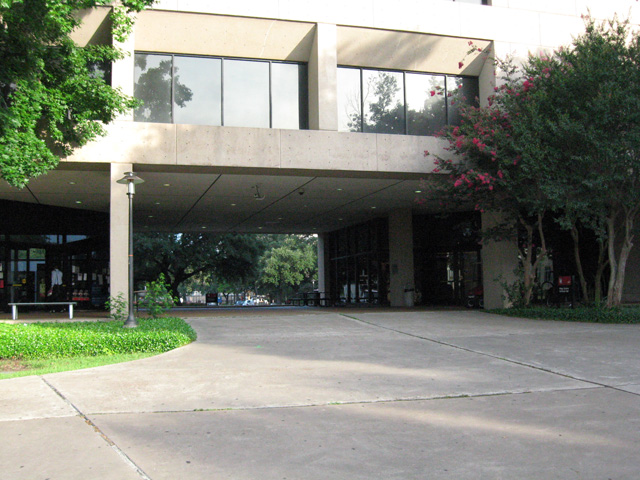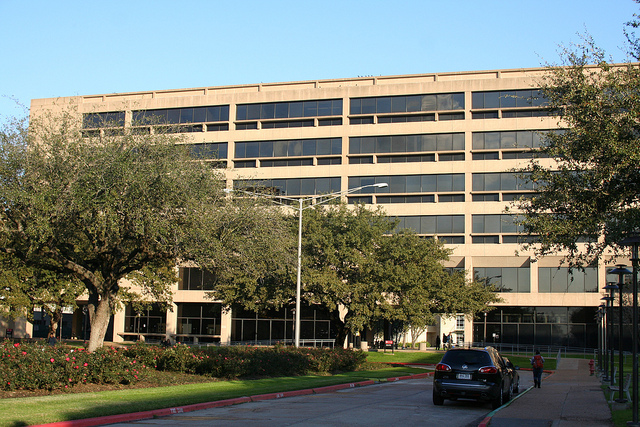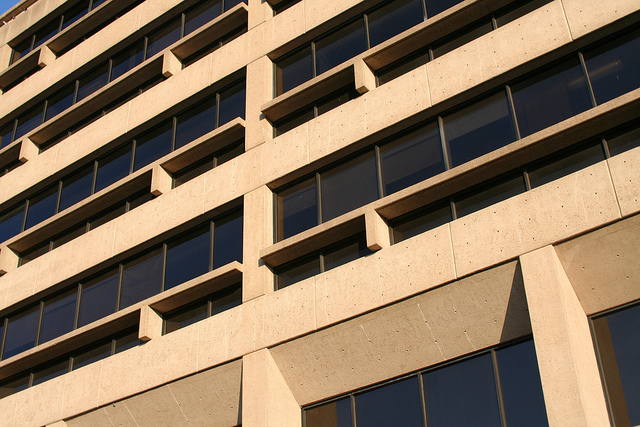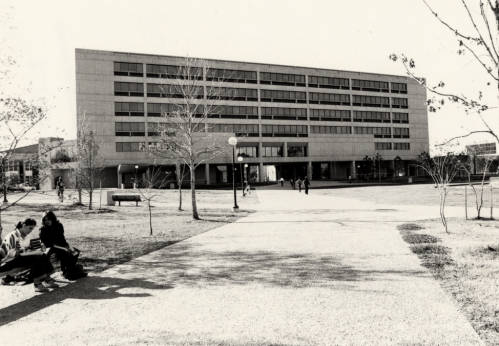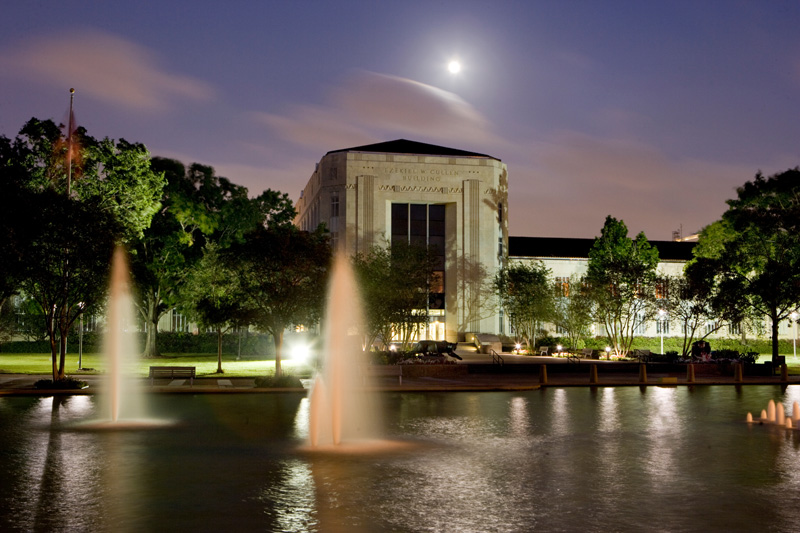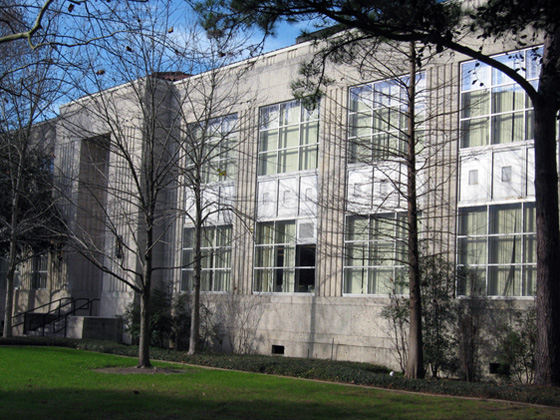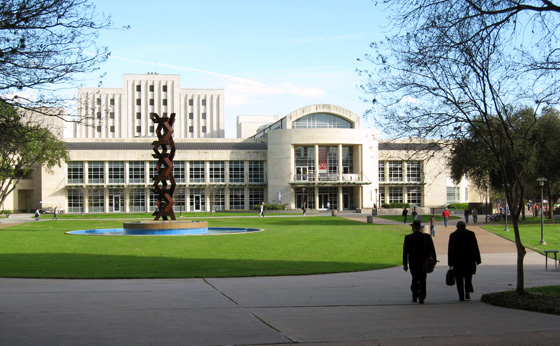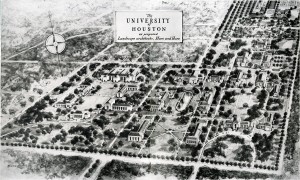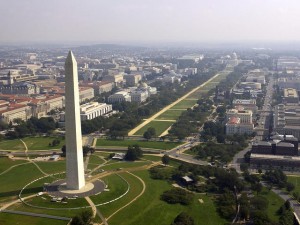
The recent post about Philip G. Hoffman Hall (PGH) failed to answer an important question: Why does it have a big hole in it? As with most cosmic questions, the answer to this one is that “it’s all connected.” In this case, PGH and its hole are connected to the change in the university’s master plan in the mid 1960s.
![1967 aerial view shows UH buildings arranged around several formal axes [UH Photographs Collection]](http://weblogs.lib.uh.edu/speccol/files/2014/05/UH-campus-1967-300x190.jpg)
UH Campus looking east (1967). Note street between Anderson Library and Ezekiel Cullen Building. UH Photographs Collection
Before the change in the master plan, a street ran through what is now Butler Plaza and passed between the Ezekiel Cullen Building and Anderson Library. See the 1967 aerial view of the campus. University planners decided to remove the street to create the plaza, and this required a new building opposite the library to provide a sense of enclosure.
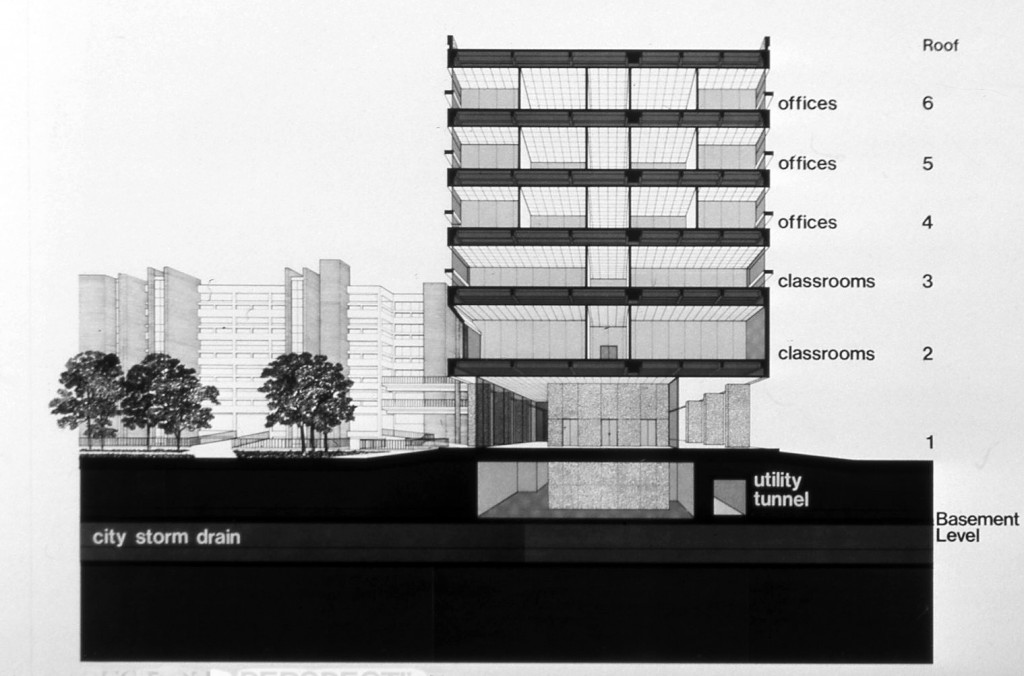
PGH, section view. Agnes Arnold Hall in background. Note storm drain below breezeway. Kenneth E. Bentsen Architectural Papers
But below the street was a major city storm sewer, and an easement prevented them from placing a building over it. Their solution was a building with a large hole in the center that left the area over the storm sewer open, providing access if it is ever needed. In the construction view below, looking to the southeast, excavation for a basement stops short of the center of the building.
![Philip G. Hoffman Hall Construction [UH Photographs Collection]](http://weblogs.lib.uh.edu/speccol/files/2014/07/PGH-Construction.jpg)
Construction of Philip G. Hoffman Hall (c. 1972) UH Photographs Collection
Approaching M.D. Anderson Library, you can’t miss Philip G. Hoffman Hall (PGH) nearby. Completed in 1974, it honors one of the university’s most important leaders and is a major landmark at the center of the campus. PGH and its neighbor, Agnes Arnold Hall, were designed by Kenneth Bentsen (UH 1952), a talented architect responsible for Houston’s Summit sports arena (1975) and other important buildings. PGH reflects the minimalist, modern style of the early 1970s. This style is not universally popular today, but formally this is a good building and I would like to show you why.

Philip G. Hoffman Hall from the east, behind Peter Forakis’ Tower of the Cheyenne. Photo by the author
Despite its large size, PGH is an elegant building. The strong horizontal lines visually lower its height. The façade is based on a grid, of course, but like a tartan plaid, the elements are interwoven, with some lines projecting and others suppressed. This is a subtractive composition where layers of the building are peeled away—slightly at the upper levels where, within each bay of windows, the projecting concrete fins provide a continuous bass note for the rhythm of repeating window mullions behind. There is a more pronounced cutting away at the lower levels; this culminates in the deep ground-floor gallery facing the plaza and the breezeway that penetrates the center. The slightly sculptural, three-dimensional facade prevents this from being just another boxy modern building.
Bentsen’s attention to detail can go unnoticed unless you look closely. The concrete construction is left exposed—a common practice at the time—but concrete can be finished in many ways, from very smooth to very rough. It is not always done as well as it is here. Bentsen specified a slight texture and a warm color that is pleasing to the eye. The wall surface is scored by the repeating pattern of small holes left by the concrete pouring process. They form an almost imperceptible grid of dots that enlivens the surface of the building. The holes have to be there, but the designer decides how to arrange them.
PGH is also impressive because of the way it is scaled to fit the plaza in front of it. The building occupies an important place at a campus crossroads, and visually it commands both the plaza and the broad avenue that it overlooks on the west. PGH should be understood at an urban scale, not a human scale: It is supposed to relate to the size of the plaza, not the size of the people in the plaza.
PGH is worth another look the next time you pass by. Records of this and other Bentsen buildings are housed in the Kenneth E. Bentsen Architectural Papers in the library’s Special Collections Department, where they are currently being processed.
The buildings that define the edges of Cullen Family Plaza—Roy Cullen (1939) and the Science Building (1939), designed by Lamar Cato, and Ezekiel Cullen (1950) by Alfred Finn—are the University of Houston’s original buildings. They were designed in a style usually called “stripped classicism” or sometimes “WPA modern” (so called because it appeared on many post offices and other government buildings erected by the Works Progress Administration during the Great Depression).
Stripped classicism is a “transitional” style because it represents a bridge from the traditional Greco-Roman classical architectural style to the modern style. In the 1930s, the modernist revolution swept the fields of art and architecture. Architects who practiced in the traditional styles felt the pressure to conform to changing popular tastes. Their solution was to transform the well-known classical architecture for those seeking something more modern.
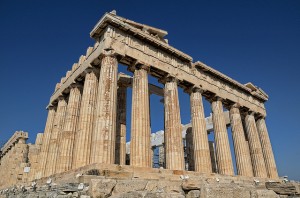
The Parthenon by Frank Durr / CC BY-NC-ND 2.0
Classical architecture has a distinctive rhythm of solid and void—the masses and the gaps between the masses. In the ancient Greek Parthenon, the best known classical temple, the roof is supported by a row of columns with voids between them at regular intervals. The columns have grooves known as “flutes.” The columns support carved blocks called “capitals.” Modern architecture, however, is distinguished by its formal abstraction. The modern architect reduces the design to its formal essentials—a geometric box, for example—and avoids the superficial detail found in most traditional styles.
Proponents of stripped classicism abstracted the classical style by eliminating the ornament on the surface and making the building look more flat and two-dimensional. Stripped classicism was much more formal and conservative than other modernist styles of the day, which made it acceptable for public buildings.
The relationship between the university’s original buildings and the classical style that inspired them can be seen in this picture of the Science Building, although E. Cullen and Roy Cullen have similar details. Marching across the face of the building is a series of vertical masses separated by voids with the same regular pattern as a classical temple. To achieve this look, the edge of the second floor between the windows (the “spandrel”) is treated as part of the window frame and visually disappears. The window openings suggest continuous voids.
It’s easy to see references to the classical temple in the building’s details. The areas between the windows are carved with shallow grooves to represent the column flutes, and above the grooves a row of circular depressions suggests the capitals. The building’s limestone cladding also helps the viewer make the connection with the ancient stone temples.
Stripped classicism appeared in the 1930s and already looked dated by the time E. Cullen opened in 1950. The style was too fussy and conservative for the postwar era. But public tastes change. In the six decades since, the university has come to appreciate the architecture of its original buildings. When Shepley, Bulfinch, Richardson & Abbott designed the expansion of M.D. Anderson Library (2005), they looked to E. Cullen for inspiration. The main building’s transitional style has proved to be more enduring than anyone expected when the building was completed.
The following continues a series of contributions from Dr. Stephen James, who works with the Architecture and Planning collections here at the University of Houston Special Collections. Dr. James holds a Ph.D. in Architectural History from the University of Virginia and for many years was a lecturer at the University of Houston College of Architecture.
Our look at campus architecture today begins with Cullen Family Plaza, a favorite gathering place at the University of Houston. The plaza honors the Cullen family, whose patronage and leadership have shaped the university from its earliest days. Located in front of the Ezekiel Cullen Building, it is—along with the nearby Anne Butler Plaza in front of the M.D. Anderson Library—the social heart of the campus. Both plazas are relatively recent additions to the campus and resulted from a major overhaul of the university’s campus planning principles in the mid 1960s.
The campus was laid out in the 1930s by the Kansas City landscape architecture firm of Hare & Hare, which also designed Houston’s Hermann Park. Hare & Hare created a very formal, axial plan for the university, with the main buildings arranged in a rectilinear fashion and aligned symmetrically on either side of a centerline or axis. Several such axes can be seen in a 1930s rendering of the master plan from the Library’s Special Collections Department and in a 1967 aerial photograph from the UH Digital Library.
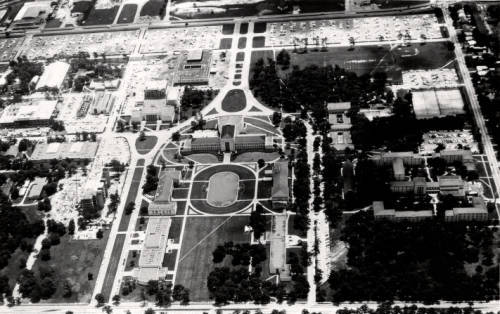
1967 aerial view shows UH buildings arranged around several formal axes, from the UH Photographs Collection and available for download in the Digital Library
This type of formal, axial planning, which dates back to ancient Rome, is used with monumental public buildings and is intended to convey a sense of grandeur or importance (think of the Mall in Washington, D.C.). The traditional architecture of the buildings represents the important public institutions housed within. Their predictable arrangement implies a reassuring sense of order, and their large scale makes the viewer seem insignificant in relation to these institutions. Formally, the spatial void in the center (the lawn or mall) is not meant to be inhabited; it reinforces the buildings that define it and helps tie the ensemble together.
The events of the 1960s changed public attitudes toward authority. Such formal planning became unpopular, as architects tried to humanize public institutions and make them less intimidating. Many campuses took on a “suburban” appearance by using more naturalistic landscape design and less rigid building placement.
These trends influenced the University of Houston, which abandoned its original master plan in 1966 to give the campus the casual, park-like character that it has today. Planners placed new buildings such as Farish Hall (1970), McElhinney Hall (1971), and Hoffman Hall (1974) across the important axes to create small plazas that might become centers of public activity in their own right, rather than simply reinforcing the importance of the buildings around them.
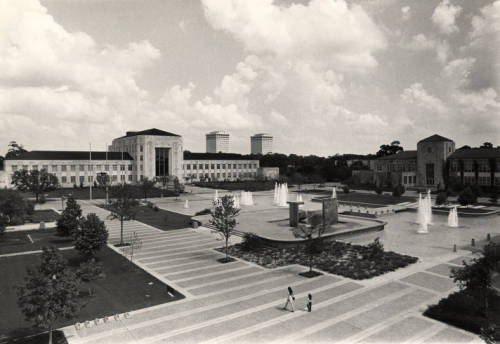
Cullen Family Plaza in the 1970s, shortly after its completion, from the UH Photographs Collection and available for download in the Digital Library
Cullen Family Plaza resulted from this change in 1972. Landscape architect Fred Buxton replaced the elliptical reflecting pool in front of E. Cullen with a large water pool that spanned the distance between the Roy Cullen and Science Buildings. Dramatic water jets introduced a dynamic element that balanced Lee Kelly’s large metal sculpture called “Waterfall, Stele, and River.” Farish Hall, completed shortly before the plaza, provided the necessary enclosure on the west side. In the four decades since, the landscaping has matured to soften the edges and further isolate the plaza from the distractions of the campus.
The UH Digital Library’s University of Houston Buildings Collection is an excellent resource for anyone looking for more information about the history of Cullen Family Plaza.
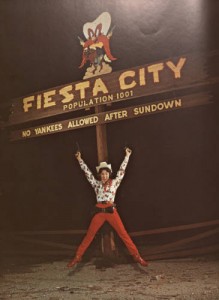
from the 1957 Houstonian yearbook and available for download in the Digital Library
As the heat and humidity crank up and students return to campus to begin the summer session, the changing of the season also marks the final days of the latest exhibition from the University of Houston Special Collections. “Frontier Fiesta: The Greatest College Show on Earth,” available for viewing on the first floor of the M.D. Anderson Library, ends its run on Friday, June 6th.
Every spring, give or take a few years, Frontier Fiesta sees students at the University of Houston turn a small part of our campus into a living and breathing ol’ western frontier town known as Fiesta City, complete with cook-offs, music, and themed performances. The annual event debuted in 1940 and WWII threatened to end the tradition before it even began. Following the war years, however, it resumed and grew into an event like no other. By the early 1950s it had been proclaimed by Life magazine to be the “Greatest College Show on Earth,” and its rising popularity served as a fundraising mechanism for the students, bringing in funds for a campus recreation center and swimming pool in its early years and later helping to provide scholarships.
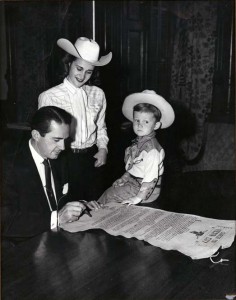
Gov. Allan Shivers signs the Fiesta City charter making it an official township in the state of Texas (1952)
Through the years the event has grown, morphed, and has now further evolved for a new generation of Cougars and Houstonians. All the while, Frontier Fiesta has provided a subtle insight into the story of the University itself and its relationship with the City of Houston. Celebrating the history of one of the University’s most enduring and colorful traditions, “Frontier Fiesta: The Greatest College Show on Earth,” curated by University Archivist Mary Manning, tells that remarkable story with artifacts from the UH Frontier Fiesta Collection, items from other collections in the University Archives, as well as mementos and keepsakes generously shared by University and community partners.
We will miss our “Mini-Fiesta-City” that has become a fixture on the Library’s first floor, but as the seasons bring us something new so does our calendar of exhibits. Up next? Well, we won’t spoil the fun too much. However, Archivist Julie Grob is currently hard at work curating our next exhibit, pulling from the rich Contemporary Literature collections held here at the University of Houston. Look for the curtain to rise on this exhibit Friday, June 20th.
* Until then, don’t miss this last chance to catch the Greatest College Show on Earth–until spring 2015, that is. Another spring will see tomorrow’s UH students continue that tradition started back in 1940 and, once again, resurrect Fiesta City out of some dusty corner of campus.
